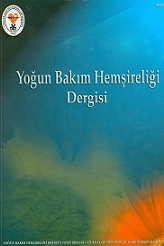Kardiyoloji Servislerinde Çalışan Hemşirelerin Kalp-Akciğer Canlandırması Uygulamasına İlişkin Görüşleri
Amaç: Araştırma, hemşirelerin Kalp-Akciğer Canlandırması (KAC) uygulamasına yönelik deneyimlerini, aldıkları eğitimi ve bu konudaki görüşlerini belirlemeyi amaçlamaktadır. Gereç ve Yöntemler: Tanımlayıcı tipte bir araştırma olan çalışma, Ocak-Nisan 2009 tarihlerinde bir özel dal devlet hastanesinde gerekli izinler alınarak yapıldı. Evreni, kardiyoloji ve kardiyovasküler cerrahi servislerinde çalışan 88 hemşire, örneklemi ise araştırmaya katılmaya gönüllü 84 hemşire oluşturdu. Veriler, 21 soruluk bilgi formuyla toplandı. Verilerin değerlendirilmesinde, frekans, ortalama, kikare ve t-testi yöntemleri kullanıldı. Bulgular: Hemşirelerin yaş ortalaması 30, mesleki deneyimi yaklaşık 10 yıl, kurumsal deneyimi yaklaşık 5 yıldır. Katılımcıların %42,9’u sağlık meslek lisesi mezunudur, %46,4’ü KAC uygulama konusunda bilgi ve becerisinin yeterli olduğunu, %38,1’i daha önce KAC uyguladığını, %50’si KAC eğitimi aldığını ifade etti. Katılımcılar, çalıştığı birimde kardiyak arrestin ilk tespitçisinin (%77,4) ve ilk müdahale edenin (%67,9) hemşire olduğunu belirtti. Katılımcıların %72,6’sı tüm hemşirelerin KAC eğitimi alması gerektiğini, %46,4’ü hizmet içi eğitim, %44’ü kurs ve sertifika şeklinde eğitim verilmesini önerdi. KAC eğitimlerinin özel kurs ve sertifika şeklinde olmasını önerme ile hemşirelerin öğrenim düzeyi arasında anlamlı fark vardı. Katılımcıların, yaşı, öğrenim düzeyi, mesleki deneyimi ile KAC eğitimi alma, KAC uygulama ve KAC konusunda kendini yeterli bulma arasında istatistiksel olarak anlamlı farklılık bulunmadı. Sonuç: Hemşirelerin KAC konusunda kendini yeterli hissetmesini mesleki deneyim ve daha önce KAC uygulamanın olumlu etkilediği, KAC eğitimi almanın ise etkilemediği belirlendi. KAC eğitimlerinin beceriye odaklanması ve güncellenmesi önerildi.
Anahtar Kelimeler:
Kalp-akciğer canlandırması, hemşire, arrest
Opinions of Nurses Working in Cardiology Services on Cardiopulmonary Resuscitation Applications
Objective: The study aims to determine the experiences, training and opinions of nurses on cardiopulmonary resuscitation (CPR) applications. Gereç ve Yöntemler: This descriptive study was conducted in a private branch state hospital in January-April 2009 after necessary authorizations were received. The study population comprised 88 nurses working in cardiology and cardiovascular surgery services and the sample group comprised 84 nurses who volunteered. Data were collected by using 21-item information forms. Frequency, average, chi-square and t-test methods were used in data evaluation. Results: Average ages of the nurses were 30, their professional experience was about 10 years and their corporate experience was about 5 years. 42,9% of participants were vocational high school graduates, 46,4% stated that they had sufficient knowledge and skills on CPR applications, 38,1% stated that they had applied CPR before, 50% stated that they received CPR training. The participants stated that cardiac arrest was first established by the nurse (77,4%) and the initial treatment was given by the nurse (67,9%) in their units. 72,6% of participants suggested that all nurses must be given a CPR training, 46,4% stated that in-service training must be provided and 44% suggested a course-and-certification training. There was a significant difference between the suggestion of CPR trainings being of private course and certification type and the educational level of nurses. No statistically significant difference was observed between the ages, educational levels, professional experiences and their CPR training status, and finding themselves competent in CPR and in the application of it. Conclusion: It was determined that professional experience and previous experiences of CPR application had a positive effect on nurses feeling they are competent in CPR. It is recommended that CPR trainings should focus on the skills and be updated.
Keywords:
Cardiopulmonary resuscitation, nurse, arrest,
- ISSN: 1302-0498
- Başlangıç: 1997
- Yayıncı: Yoğun Bakım Hemşireler Derneği
Sayıdaki Diğer Makaleler
Yoğun Bakım Ünitesinde Etik İkilemler
Hülya ÜSTÜNDAĞ, Fatma ETİ ASLAN
Cerrahi Yoğun Bakım Ünitesine Yatan Hastaların Retrospektif Değerlendirilmesi
Yoğun Bakım Ünitesi ve Tamamlayıcı Tedaviler
Yoğun Bakımda Ventilatöre Bağlı Gelişen Pnömoninin Önlenmesi
